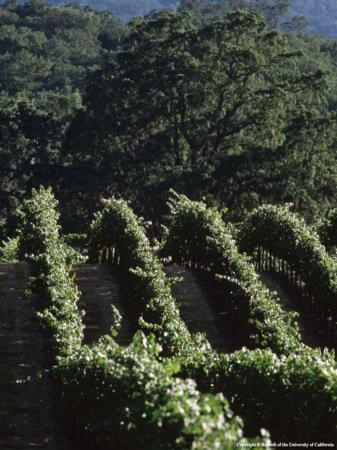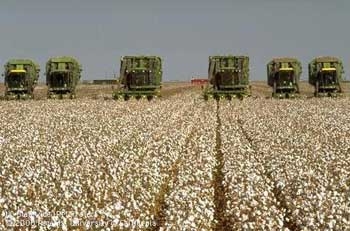Posts Tagged: economy
A weak economy is pinching the premium wine industry
Like many business sectors, the California premium wine industry is suffering under the weak economy, according to an article published over the weekend in the Santa Rosa Press-Democrat.
Wine produced in Napa and Sonoma counties used to be cheap alternatives to French wines. Now connoisseurs are turning to less expensive wines from Australia, South America and California's Central Valley.
UC Cooperative Extension viticulture farm advisor Glenn McGourty told reporter Glenda Anderson that he believes consumers will return to North Coast wines when the economy improves.
“Lodi is kind of like the person you go out with that's really hot but you don't want your parents to see them,” he was quoted.
The story opened with the travails of McDowell Valley Vineyards of Hopland, which is facing possible foreclosure Nov. 5. McGourty said the McDowell situation is not unique.
“A lot of people are on the ropes,” he was quoted.
Wineries are cutting back on how much they buy and the prices they'll pay for grapes.
The McDowell vineyard reported that the value of its premium winegrapes has dropped from $1,400 a ton to about $700 a ton. A winery offered to buy 32 tons of McDowell sauvignon blanc at $600 a ton. In Lodi, winegrapes average about $500 a ton, the story said.

The wine market decline is putting some people out of business.
Lack of water is killing Kern County ag
The Bakersfield Californian reported that it isn't just the listless economy ravaging Kern County agriculture. The industry's woes are pinned on water.
Reporter Courtenay Edelhart spoke to the director of the UC Agricultural Issues Center, Dan Sumner, about the national economic downturn's impact on ag. With the exception of the dairy industry, Sumner said, agriculture prices haven't been that bad over the past year.
The state of California has, however, suffered three years of drought - with implications that even last month's series of storms cannot reverse. The Bakersfield area had 5.10 inches of rain between July 2008 and June 2009, and only 2.38 inches during the same period a year earlier, the article said.
But even more significantly, recent court and government actions regarding water allocations are not satisfying southern San Joaquin Valley agriculture's thirst.
- In 2008, a federal judge restricted pumping into agricultural canals from the Sacramento-San Joaquin Delta to protect Delta smelt
- The California Department of Water Resources said it will only be able to deliver 5 percent of requested State Water Project water this year to the Bay Area, San Joaquin Valley, Central Coast and Southern California, although that figure may be updated next month
- The U.S. Bureau of Reclamation allowed only a 10 percent allocation for agriculture south of the delta.
The result: 40,000 acres of Kern County farmland aren't being farmed and, in December 2009, Kern County had 1,400 fewer farm jobs compared with December 2008.

Irrigating young cotton.
Demand is down for California cotton
California farmers are known for growing some of the world's finest cotton. Even though, production has been on a steady downward decline since a high of 1.3 million acres in 1979. This year, only about 200,000 acres of California cotton are being cultivated.
The drop can be attributed to a number of factors, according to an article today in AgAlert about the repercussions for the cotton ginning industry. Nearly two-thirds of the cotton gins that operated in California 10 years ago have closed.
Severe water shortages, competition from other countries, high input costs, the worldwide economic crisis are undermining the throne of California's King Cotton.
AgAlert assistant editor Christine Souza spoke to UC Cooperative Extension cotton specialist Bob Hutmacher for the story.
"One of the things that has not helped in the last couple of years is some of the prime production areas for cotton are where we have had these tremendous water limitations," Hutmacher was quoted in the article. "That punched the daylights out of cotton acreage as much or more than anything else."
Hutmacher is director of UC's West Side Research and Extension Center, which sits in the heart of cotton country. Like neighboring farmers, the center received only 10 percent of its normal water allocation this summer and had to tap its deep wells and cut production during the summer to keep research projects on track.
California's long-fiber cottons allow manufacturers to make luxurious high-thread-count linens and soft yet strong t-shirts. But around the world, consumers are keeping their clothing longer and opting for lower-quality cotton products that don't depend so much on California's superior product.
"Part of it is the varieties and part of it is the climate, but one of the things that California still can do better than just about anybody is produce a world-class-quality cotton crop," Hutmacher said.
Third-generation cotton farmer Steve Wilbur of Tulare hasn't given up hope.
"There is a future, we just don't know what it looks like," he was quoted.

Cotton harvest.
California Report covers dairies' desperate times
A long excerpt from a recent UC online seminar for dairy operators on suicide prevention was used in a lengthy segment about the plight of California dairies on the California Report this morning. The story, by Fresno NPR reporter Sasha Khokha, noted that the Los Angeles Times reported in May that two dairymen have committed suicide as dairy industry profits crash. Currently, dairy operators earn about half what it costs them to produce milk.
Much of Khokha's story was pulled from an emotional interview with Point Reyes dairy operator Joey Mendoza, whose immigrant grandfather started the dairy nearly 100 years ago.
"It's sad, but it's something you have to do," Mendoza told the reporter, his voice cracking with despair. "There are guilt pains because of the heritage. Everybody worked so hard to build this thing and you're the one that has to terminate it and let it go. It's humiliating and you're not very proud of yourself to do something like this."
Mendoza has decided to participate in a herd retirement program that requires dairies to sell the entire herd for slaughter and stop milking cows for at least a year. The program is expected to take about 100,000 cows out of the national milking herd of 9 million, Khokha reported. Mendoza said he may try to open the dairy again one day as an organic operation.
Suicide prevention a topic for UCCE webinar
The dire economic straits in which many California dairy operators find themselves have prompted UC Cooperative Extension to collaborate with other agencies to provide a suicide prevention online seminar, according to an article in Dairy Herd Management.
The webinar, held this morning, covered farmer stress, depression and suicide prevention. According to an article published in the Los Angeles Times late last month, two dairy operators have recently committed suicide. Low milk prices that have dairy farmers selling cows for hamburger meat and threatening to dump milk into sewers may be partly to blame.
Current milk prices are about half of what it costs California producers to feed and milk their herds, the Times article said. Every gallon sold in the supermarket represents a loss on the farm. The pain is being felt throughout the U.S., but it's especially severe in California, where1,800 dairies produce $7 billion worth of milk annually, more than one-fifth of the nation's supply.
The Dairy Herd Management article ends with links to additional resources, including a story in the May issue of the magazine, Recognize the Signs of Stress and Depression and a link to its Crisis Management Resource Center.

